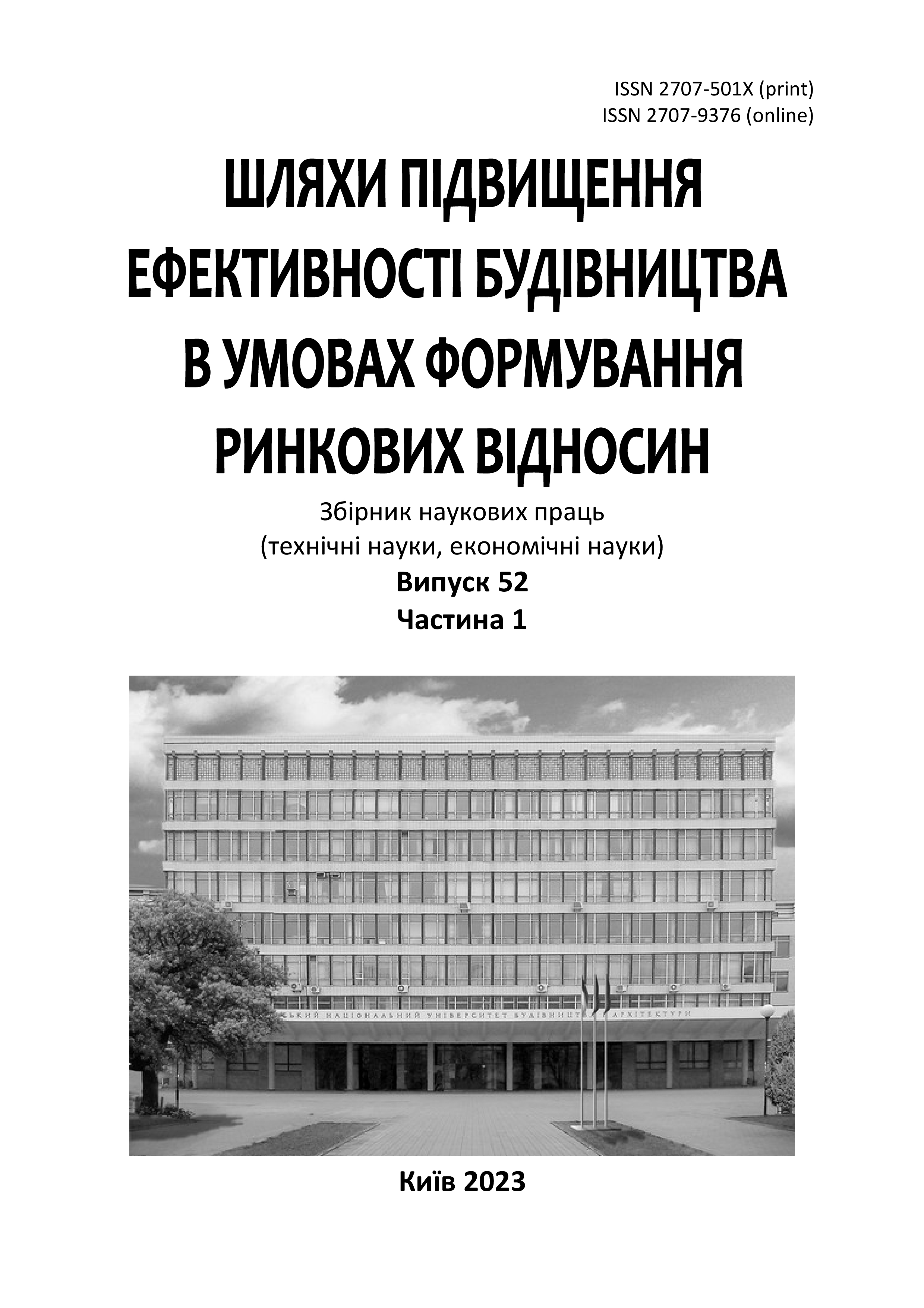Introduction to the theory of sustainable operation of technological systems for building reconstruction
DOI:
https://doi.org/10.32347/2707-501x.2023.52(1).123-137Keywords:
technology, reconstruction, theory of sustainable functioning, adaptive dynamically transforming, technological systemsAbstract
The article outlines the main provisions for increasing the stability of the functioning of technological systems in complex and changing conditions of reconstruction, accepted as a system of conceptual, theoretical, and methodological foundations for the formation of their morphological appearance as adaptive dynamically transforming technological systems. Increasing the stability of the functioning of technological systems in complex and dynamic conditions of reconstruction is ensured by the implementation of strategies: A-strategy. Reduced dynamics of environmental conditions; B-strategy. Ensuring an increased level of homeostasis of the technological system in relation to the external environment and the dynamics of its states. The A-strategy is implemented at the stages of preparation for reconstruction and in the process of its implementation, and the B-strategy is implemented by the formation of a technological system that ensures its invariance with respect to changes in the states of the external environment and which is carried out by increasing the functional inertia of the system, functional and structural redundancy. The author called such systems adaptive dynamically transforming technological systems. Adaptive dynamically transforming technological systems are endowed, on the one hand, with the properties of astatic systems – as systems with variable morphology, capable of detecting purposeful adaptive behaviour while maintaining internal balance, and, on the other hand, with the properties of static systems – as high-performance specialized systems with states. Astatic properties ensure optimization of costs for transforming the morphology and function of a technological system, as well as limiting system states to the minimum possible level, and static properties optimize differential effects on a variety of characteristic production situations. The use of adaptive dynamically transforming technological systems allows us to resolve the fundamental parametric contradiction in building reconstruction technology – highly efficient and sustainable implementation of non-stationary construction processes in complex and changing conditions of building reconstruction.
References
Osipov, A.F. (2000). Osnovnye principy proektirovaniya dinamicheski transformiruyushihsya tehnologicheskih sistem. Prikladna geometriya ta inzhenerna grafika. Vip. 67. Р. 162–165.
Osipov, А.F. (2005). Zagalna koncepciya ta osnovni zakonomirnosti rozvitku skladnih virobnichih sistem v budivnictvi. Mistobuduvannya ta teritorialne planuvannya. Vip. 22. Р. 219–230.
Osipov, A.F. (2013). Teoreticheskie osnovy ustojchivogo funkcionirovaniya tehnologicheskih sistem. Mistobuduvannya ta teritorialne planuvannya. Vip. 48. Р. 321-328.
Osipov, A.F. (2015). Adaptivnye dinamicheski transformiruyushiesya tehnologicheskie sistemy rekonstrukcii zdanij. Usloviya primeneniya i strukturno-funkcionalnye urovni proektirovaniya. Mistobuduvannya ta teritorialne planuvannya. Vip. 57. Р. 321-332
Osipov, A.F. (2016). Adaptivnye dinamicheski transformiruyushiesya tehnologicheskie sistemy. Metodologiya proektirovaniya organizacionno-tehnologicheskih reshenij rekonstrukcii zdanij: monografiya. K.: CP «Komprint». 364 р.
Osipov, A.F. (2022). Adaptivnye dinamicheski transformiruyushiesya tehnologicheskie sistemy. Metodologiya proektirovaniya organizacionno-tehnologicheskih reshenij rekonstrukcii zdanij: monografiya. 2-e izd. dop. i isp. K.: FOP Yamchinskij O.V.. 393 р.
Gusakov, A.A., Ginzburg, A.V., Veremeenko, S.A. at al (1994). Organizacionno-tehnologicheskaya nadezhnost stroitelstva. Red. A.A. Gusakova. M.: SvR-Argus. 472 p.
Gusakov, A.A. (1993). Sistemotehnika v stroitelstve. M.: Strojizdat. 368 р.
Druzhinin, V.V., Kontorov, D.S. (1985). Sistemotehnika. M.: Radio i svyaz. 200 р.
Reliability and efficiency in technology: Handbook: In 10 volumes / Ed. advice: V.S. Avduevsky (prev.) and others. M.: Mechanical Engineering, 1986. T. 1: Methodology. Organization. Terminology / Ed. A.I. Rembezy. 224 р.
Tomaev, B.M. (1983). Nadezhnost stroitelnogo potoka. M.: Strojizdat. 128 р.
Belyakov, Yu.I., Snezhko, A.P. (1988). Rekonstrukciya promyshlennyh predpriyatij. K.: Vysha shk.. 255 р.
Belyakov, Yu.I., Osipov, A.F., Akimov, F.N. (1991). Effektivnoe ispolzovanie betonoukladochnoj tehniki v stesnennyh usloviyah rekonstrukcii prompredpriyatij. Mehanizaciya stroitelstva. № 4. Р. 23–25.
Belyakov, Yu.I., Romanushko, E.G., Osipov, A.. i dr.. (1986). Organizacionno-tehnologicheskie pravila proizvodstva betonnyh i zhelezobetonnyh rabot po ustrojstvu fundamentov i zaglublennyh sooruzhenij pri rekonstrukcii promyshlennyh obektov.K.: Minpromstroj USSR. 212 р.
Belyakov, Yu.I., Romanushko, E.G., Osipov, A.F. i dr. (1986). Organizacionno-tehnologicheskie pravila proizvodstva rabot po ustrojstvu buronabivnyh svaj pri rekonstrukcii prompredpriyatij. K.: Minpromstroj USSR. 96 р.
Osipov, A.F. (1998). Effektivnost funkcionirovaniya organizacionno-tehnologichesk ih sistem v usloviyah rekonstrukcii promyshlennyh predpriyatij. Shlyahi pidvishennya efektivnosti budivnictva v umovah formuvannya rinkovih vidnosin. Vip. 3. Р. 120–122.
Downloads
Published
How to Cite
Issue
Section
License

This work is licensed under a Creative Commons Attribution 4.0 International License.
Authors who publish with this journal agree to the following terms:
- Authors retain copyright and grant the journal right of first publication with the work simultaneously licensed under a Creative Commons Attribution License that allows others to share the work with an acknowledgement of the work's authorship and initial publication in this journal.
- Authors are able to enter into separate, additional contractual arrangements for the non-exclusive distribution of the journal's published version of the work (e.g., post it to an institutional repository or publish it in a book), with an acknowledgement of its initial publication in this journal.
- Authors are permitted and encouraged to post their work online (e.g., in institutional repositories or on their website) prior to and during the submission process, as it can lead to productive exchanges, as well as earlier and greater citation of published work (See The Effect of Open Access).

